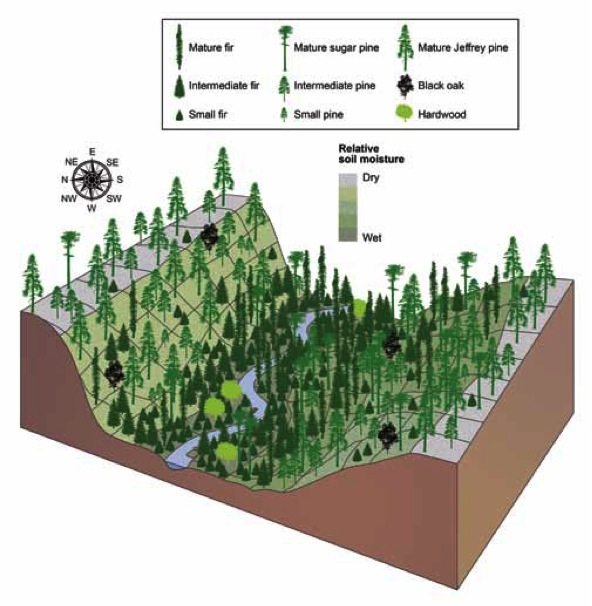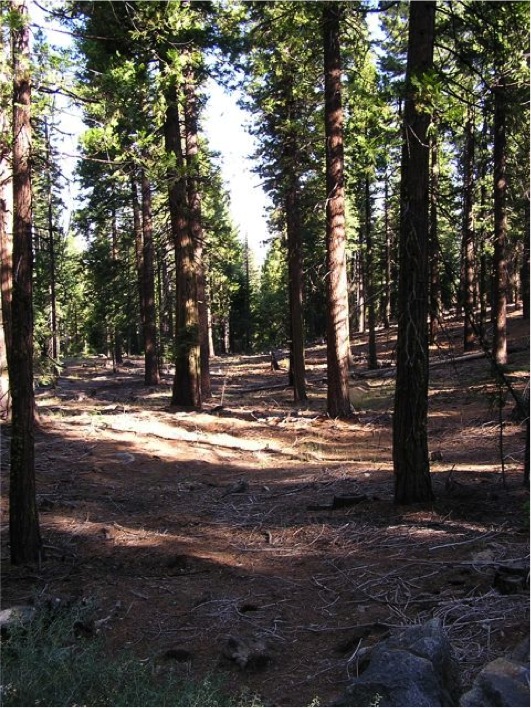Along ridges and the adjacent upper slopes, winds dry the forest, sun often bakes the soil, and trees can struggle for moisture during long summer seasons or years of drought. In the GTR-220 science-based approach to managing forests, the ridges and the upper 1/3 of slopes are intentionally thinned widely to create very open conditions to make it easier to stop wildfires along ridge-tops and to reduce competition by trees for limited moisture. In mid-slope areas, more trees are left when logging and fuel reduction projects treat those areas. But mid-slope forest conditions are still highly diverse and open, with individual trees and small patches or clumps of conifers. The lowest 1/3 of slopes and the drainages are managed for the most trees. Because there is more moisture and less drying from the sun, shady lower slopes can provide areas of closed canopy habitat as well as scattered individual trees and many patches and clumps. Openings may be smaller, but even in the lower 1/3 of a slope, diversity is a key objective to provide varied habitat areas for wildlife and to reduce extreme wildfire risk. The study area that gained so much attention during the two recent science events is the Experimental Forest near Pinecrest. Some units were left unmanaged, some units were thinned uniformly, and other units were logged using variable condition objectives. Prescribed fire was also applied in some units to evaluate how getting fire back into the forest ecosystem can affect plant diversity, tree survival, and tree growth. The area at right is an example of how the forest looks AFTER variable treatment logging. In a few years, re-growth by ferns, groundcovers, and bushes will make the treated area look even more park-like. CSERC was strongly supportive of the variable treatment study and has long been an advocate for returning fire into forests under carefully managed prescriptions so that unnatural fuel accumulations can be reduced and ecological processes can benefit. A key challenge now is to take the broad collaborative support for applying the science-based treatments on a much greater scale and to “catch up” with decades of overly dense forest conditions.
The lowest 1/3 of slopes and the drainages are managed for the most trees. Because there is more moisture and less drying from the sun, shady lower slopes can provide areas of closed canopy habitat as well as scattered individual trees and many patches and clumps. Openings may be smaller, but even in the lower 1/3 of a slope, diversity is a key objective to provide varied habitat areas for wildlife and to reduce extreme wildfire risk. The study area that gained so much attention during the two recent science events is the Experimental Forest near Pinecrest. Some units were left unmanaged, some units were thinned uniformly, and other units were logged using variable condition objectives. Prescribed fire was also applied in some units to evaluate how getting fire back into the forest ecosystem can affect plant diversity, tree survival, and tree growth. The area at right is an example of how the forest looks AFTER variable treatment logging. In a few years, re-growth by ferns, groundcovers, and bushes will make the treated area look even more park-like. CSERC was strongly supportive of the variable treatment study and has long been an advocate for returning fire into forests under carefully managed prescriptions so that unnatural fuel accumulations can be reduced and ecological processes can benefit. A key challenge now is to take the broad collaborative support for applying the science-based treatments on a much greater scale and to “catch up” with decades of overly dense forest conditions.

